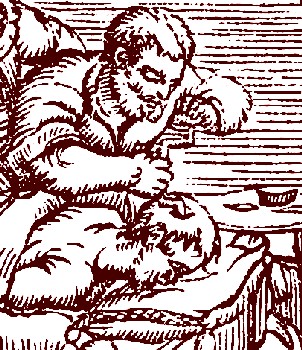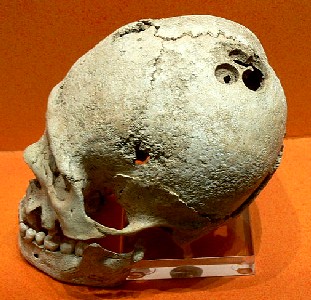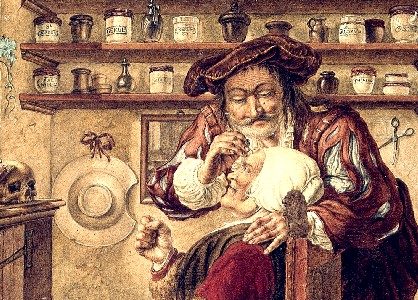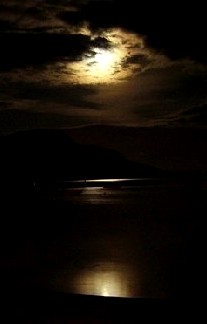
Head Surgery Page Menu: 1 2 3 4 5 6 7 8 9 10 11 12 13 14 Next>>
Head Surgery During the Golden Age of Piracy, Page 3
Theory: When to Trepan a Fractured Skull

From Chirurgiae Universalis Opus
Absolutum, Giovanni
Andrea della Croce (1573).
Writing in the 4th century BC, Hippocrates identified several types of skull fractures that required trepanning. Among them were "the contusion, whether the bone be laid bare or not; and the fissure". He also felt that "an indentation (hedra) by a weapon ...attended with fracture and contusion, and even if contusion alone, without fracture, be combined with the indentation, it requires trepanning; and those which are most pressed and broken require trepanning."1
Although Hippocrates' works were still being taught in the the late 17th/ early 18th century, the types of fractures that surgeons felt required trepanning a head wound had narrowed significantly based on the recommendations found in surgical books from that time.
MIlitary surgeon Richard Wiseman explained that when "there be a Fracture of the Cranium, you ought to satisfie your self whether it be in one or both Tables [of the skull]: if it be in both... [and the surgeon doesn't believe the fracture is large enough to relieve blood trapped under the meninges] then the Trepan ought to be applied, to give vent to the Serum, and to make way for the raising [of] the deprest Bone."2 Wiseman elsewhere says "where the Fissure lieth untowardly for discharge of Matter [under the meninges], or where the Depression of the cranium is deep, there a Trepan ought to be timely applied."3
Sea surgeon John Moyle agrees in essence with this diagnoses, noting in one of his case studies that he
prescribed "Terebration [boring a hole] to discharge the extravasated [leaking] Blood from the Mininges; for the Fissure being scalped deep, was found to be through both Tables [of the skull]; and the Enclasis [hole created when the man hit his skull on something] of the Depression

Photographer: Wolfgang Sauber
Trepanned Skull, Museo del Sitio in Monte Alban
was large."4
Moyle also provides a list of symptoms which he says indicate that a skull fracture has passed through both tables, the brain is concussed and there is blood trapped between brain and meninges. These include a patient who is raving, unable to hold the spoon in his teeth without pain, vomiting and/or is bleeding from his ears and mouth. Moyle concludes "if you see these signs of a Fracture, or any of the more erninent of them, then you may conclude there is contusion of the Brain, and the Traphine [trepan] must be used."5
John Woodall likewise explains that when "a fracture happen[s] in Cranium, with contusion and depression of both the tables thereof, so that by other conjoined and apparent accidents, as [the patient] want of some of the Sense, great vomiting with contraction of sinews, convulsions, or the like just reasons appeare, thou being forced to use the Trapan"6.
French surgical instructor Pierre Dionis doesn't agree with such timidness. He advises his students not to wait for signs such "as a Fever, Pain in the Head, and stupid Dosing [dozing - referring to unconsciousness]" 7 because they are actually indications that the blood under the skull has abcessed. Dionis instead suggests that "if at the moment the Patient receives a Blow on his Head, he falls down senseless, that is enough to justify the Trepanning hirn"8.
1 Hippocrates, On Injuries of the Head, Translated and Edited by Francis Adams, p. 452; 2 Richard Wiseman, Of Wounds, Severall Chirurgicall Treatises, 1676, p. 380; 4 Wiseman, p. 381; 4 John Moyle, Memoirs: Of many Extraordinary Cures, 1708, p. 13; 5 John Moyle, Sea Chirurgeon, 1693, p. 109; 6 John Woodall, the surgions mate, 1617, p. 4; 7,8 Pierre Dionis, A course of chirurgical operations: demonstrated in the royal garden at Paris. 1733, p. 278;
Theory: When NOT to Trepan a Fractured Skull

Artist: Jacob Katts - From the Wellcome Collection (1787)Nearly all golden age of piracy era surgical authors advised against trepanning in some cases while some surgical authors advised against it in all cases. A handful of them pointed to situations where they felt trepanning was not necessary, while others talked about the reasons that a surgeon himself may not be ready to perform such an operation.
Sea surgeon John Atkins generally resists trepanning by a surgeon, explaining "I am convinced such Extravasation [leaking of blood] between the Skull and Membrane is seldom the Consequence of a Fracture: And if so, then whatever may be said in Defence of it [trepanning when there is a fracture of the skull] ... the alledg’d Necessity of the Operation ceases"1.
He instead theorizes:
The Symptoms [that] fractured Skulls are incident to, whether immediate, or at a Distance, do not proceed from Fractures separately considered, but from the Concussion made at the same Time in the Brain by the Blow that occasioned them; for the Substance of the Brain being a Congress of Vessels of soft and fine Texture, the Violence that can break so solid a Bone as the Skull, that contains it, must indisputably rupture some of those Capillaries, and cause an Extravasation within, at the Fountain of Irradiation and Efflux of the Spirits2.
Since many surgeons at this time suggest it is not necessary to trepan a concussion where there

Checking a Head Wound, From Armamentarum Chirurgiae
Appendix, by Johannes Scultetus, p. 188 (1671)
is no fracture, Atkins concludes that the trepanning operation itself is unnecessary because both the concussion and fracture would produce the same sort of damage to the brain. From this he concludes "that not one fractured Skull in twenty is benefited by the Operation, rather more hazard of a Recovery, which when it happens, at any time after Trepanning, would I imagine, have happened without it."3
Sea surgeon John Woodall agrees that trepanning may be used more often than it is needed, although he does not completely dismiss the operation like Atkins. Woodall explains that the trepan "is an instrument of great consequent, where there is just occasion of the use thereof: but it is seldome well used, and it onely attendeth the fractures of Cranium, and yet scarse one in ten have just occasion of the use thereof. For we see daily many greevous fractures healed without it, and many more would be if no such instruments were [used]"4. He adds, "Many worthy Artists there are at this day living, which have performed great cures in fractures of Cranium, and yet never [k]new of the use of this worthy instrument."5
Woodall still sees the need to relieve the pressure on the brain by letting the blood out, although he suggests there are methods other than trepanning that can be used. He explains how he cured a patient "by cutting as much of the Cranium away [with a 'carving knife'], that the contused blood had only [to] vent."6 Thus the existing wound can be enlarged to accomplish the same end as a trepanned hole.
Pierre Dionis disagrees with Woodall about expanding the fracture. Dionis says, "All the Pains which the Ancients [surgical writers in the past] took to invent Scrapers, and other Instruments... [were] in order to put off the Trepanning as long as possible [by opening the wound further]... They waited [for] the Symptoms infallibly pointing out to them the indispensible necessity of performing it [trepanning], and sometimes those Accidents appear’d so slowly, that the Trepan became useless by that time they came to resolve to use it"6. Of course, as was outlined in the previous section, Dionis was a fan of trepanning quickly and recommended the procedure more often than many of the sea surgeons here cited.
Another point Woodall raises against trepanning in his book to young surgeons has to do with amount of training and experience a surgeon contemplating trepanation of a skull had.
I have sometimes also observed, that the young Surgeons upon a rashnesse of their opinion, and now and then, for foolish vaine glory and ostentation sake, have beene overforward in that point, of putting themselves upon the worke of piercing the Cranium, not attending the true time of nature, and by wayting to see what she can or will performe of her selfe, as in truth he ought to doe, for that the Surgeon being natures hand-maid, not her guide7.
He elsewhere expands upon this to include more seasoned surgeons, noting that with trepans "the perfect use thereof is not every mans worke, neither in every fracture (as I have said) needful to be used, because of many dangers attending the unskilfull or untimely use thereof."8 He warns "before he [the surgeon] attempt to use it, and not lightly upon suggestions or for vaine ostentation sake, not above all, for base lucres sake [to make more money], to put his patient upon the use of either of them [trepans or trephines], for that it is apparent, many great concussions, depressions, yea and some fractures are cured without any such Instrument"9.
1 John Atkins, The Navy Surgeon, 1742, p. 78; 2 Atkins, p. 79; 3 Atkins, p. 81; 4 John Woodall, the surgions mate, 1617, p. 3-4; 5, 6 Woodall,1617, p. 6; 7 Pierre Dionis, A course of chirurgical operations: demonstrated in the royal garden at Paris. 1733, p. 277-8; 7 Dionis, p. 278; 7 John Woodall, the surgions mate, 1639, p. 317; 8 Woodall,1617, p. 4; 9 Woodall,1639, p. 317
Theory: The Moon and Trepanning
Astrology and the movement of the celestial bodies have long had a connection to medicine, dating at least as far back as ancient Greece. Although the use of astrology in medicine was popular in the early Renaissance, it lost some of its luster by the golden age of piracy; most of the surgical authors under study don't mention it in relation to health concerns.

Photo: Alan Murray Walsh
Yet two surgical authors specifically mention a connection between the moon, the human brain and trepanning.
Military surgeon Richard Wiseman explains the effect of the moon on the brain in one of his case studies. "The next day was Full-moon, at which time the Brain is thought to rise high, and the Vessels are turgid [swollen]; wherefore I deferred the setting on the Trepan, contenting my self with the letting him blood"1. Sea surgeon John Woodall likewise advises that when a trepan should be used on a head wound, "the choice of the [exact] day is not materiall, as some suppose, where there is apparent necessity, except on the day of the full of the Moone, and then there is danger more than else, but necessity hath no rules."2
This idea that the brain somehow expanded and was altered during the full moon had support in other medical books from around this time.3 Johannes Scultetus provides a fuller explanation of this phenomenon, expressing a touch of doubt about its veracity. Scultetus explains that "according to some mens opinion, avoiding [Trepanning during] the full Moon, because then the brain is augmented and comes near to the skull; so that the Chyrurgian, who is not acquainted with Trepans called Abaptistoi ['unbaptized', suggesting that the surgeon had not used a trepan before], may easily hurt that with the membranes thereof"4. The origin of this concept may come from the writings of 16th/17th century philosopher Francis Bacon who noted that one of the influences of the moon is to increase moisture so "that the brain of man waxeth moister and fuller upon the full of the moon... [and] the humours in mens bodies increase and decrease as the moon doth"5. Today most people agree that the moon has no such influence on the human brain.
1 Richard Wiseman, Of Wounds, Severall Chirurgicall Treatises, 1676, p. 393; 2 John Woodall, the surgions mate, 1617, p. 137; 3 For a few examples of this, see Daniel Turner, The Art of Surgery, Vol 2, 1729, p. 208, & Thomas Fuller, 1714, Pharmacopœia extemporanea, p. 265 4 Johannes Scultetus, The Chyrurgeons storehouse, 1674, p. 199; 5 The Works of Francis Bacon, Vol. 3, "Natural HIstory, Cent. IX.", p. 187

